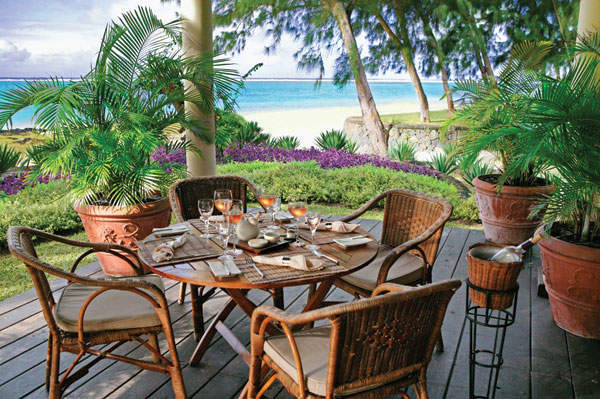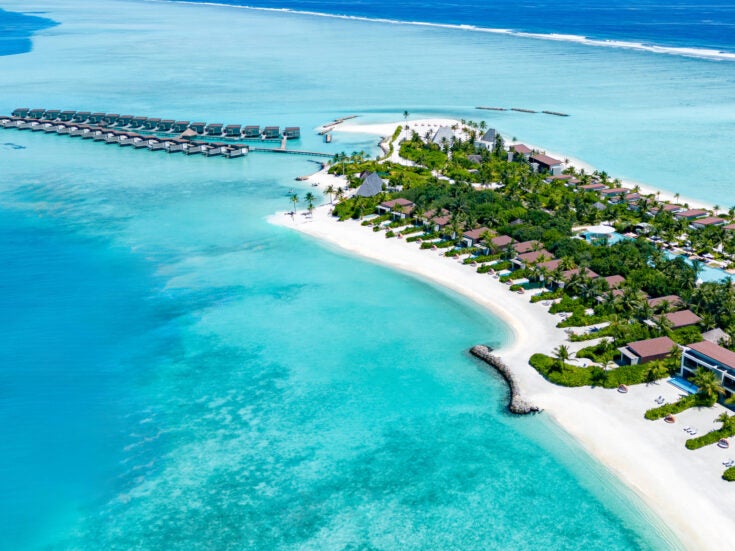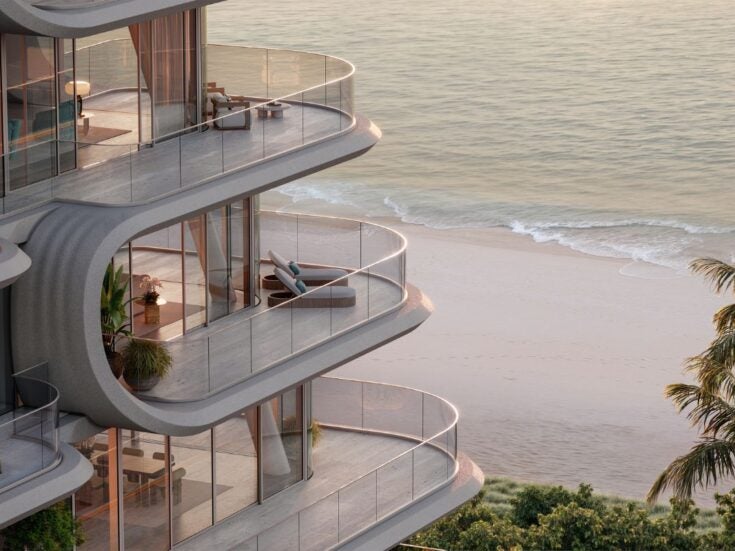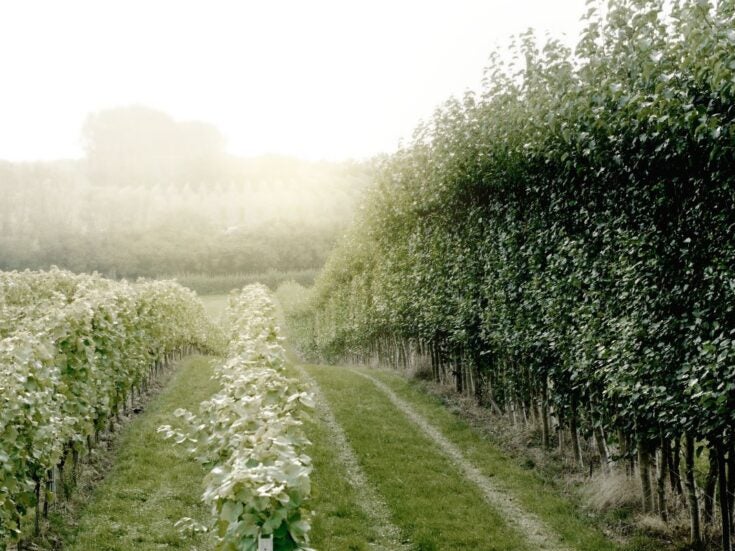

‘White-sand beaches’, ‘turquoise waters’ and ‘unspoilt pockets of calm’ — it’s the sort of travel-writer rot that sets up a weary reader for a game of cliché bingo. But Mauritius is a destination that lays out these linguistic landmines by the dozen, so on a recent visit it was a relief to be bouncing across the waves towards a coral island off the south coast on a quest not to find a ‘tranquil haven’, but to seek out animal droppings.
In just under five minutes the speedboat docked at a wooden jetty, sending the palm-sized crabs perched on it into a panic. With the exception of the water slapping quietly against the pier’s legs and a whisper of wind, it was silent on the island until Guyani, the resident biologist, arrived in a baseball cap and bomber jacket to lead the way into the forest. Along with a couple from Berkshire clutching Leica Trinovid binoculars, we picked our way through the shaded gauntlet of tree roots, passing beneath a sleeping pair of flame-orange fruit bats wrapped tightly in their own wings, the smell of cold mud a contrast from the warm salt air at the jetty.
A few metres away a boulder began to rustle and rotate and we immediately found what we were looking for. Weighing in at 207kg and 90 years old, Big Daddy (pictured top) isn’t the fastest mover on the island. It takes around 30 seconds for his eyes to bring us into focus, but the Aldabra giant tortoise can recognise his friends by their odour and the vibration of their footsteps and voices: he looked up at Guyani and blinked before leaving her a gift of fresh droppings.
The droppings are the precise reason why Big Daddy was brought from the nearby Seychelles to the Ile aux Aigrettes, a 26-hectare mini-island. Although both the Arabs and Portuguese had visited the Indian Ocean island in the early 16th century, it was Dutch settlers in 1598 who destroyed the ecosystem, clearing ebony trees to make dominoes, furniture and pianos, and culled the endemic Mauritian tortoises. Live tortoises made excellent packed lunches for sea voyages, as they could last for weeks without needing to be fed and their fat provided fuel — although a single barrel of oil required 500 tortoises.
The Ile aux Aigrettes was declared a nature reserve in 1965 and leased in the mid-1980s by an NGO, the Mauritian Wildlife Foundation. Twelve years ago conservationists attempted to rewild Mauritius and introduced 21 Aldabra giant tortoises in the hope that they would ingest the fruit of the few remaining ebony trees and disperse the seeds. Not only was this successful, but they discovered that the tortoises’ gut passages also improved seed germination, prompting more widespread, flourishing seedlings.

It takes a full morning to walk around the island, now weeded and replanted with more than 60 species of native plants. Sporadic bunches of dark green burst from the ground which Guyani proudly declared were ebony saplings. She stopped by a bony white tree whose branches curled at the ends — the kind that might feature in a Tim Burton film. It turned out to be ebony, but it’s only after the wood is 500 years old that the tree is hacked open and the dark wood extracted from the heart of the trunk, a depressing sliver that resembles a big piece of cinnamon.
It’s hard not to feel a childish thrill on seeing baby tortoises lined up and numbered like a row of First World War helmets, or hearing the tick-tick-tick of the incredibly tiny and rare olive white-eye birds. At one point a peach-pink bird with slate-grey wings and coral tail feathers sailed on to a branch, much to the delight of the Berkshire couple. In 1990 there were only nine pink pigeons left in Mauritius, but after a hasty plan of action to move them to the Ile aux Aigrettes for tracking, there are now 42, along with the Mauritius fody (pictured above), a plump, happy little bird with a chilli-red face. All these birds are endemic.
Mauritius is recognised by the International Union for Conservation of Nature as having the world’s third most threatened biodiversity. Hotels are aware that their visitors are tuning in to the conservation zeitgeist and looking for ways to feel better about their carbon footprint — even if it means flying 6,000 miles to do so. Demands for private transfers to sunbathe on the exclusive Ile-aux-Cerfs have now been replaced by requests to see conservation programmes and national parks.
Among the handful of hotels embracing the trend is the Residence Mauritius on the east coast. Inspired by turn-of-the-century colonial mansions, the Residence (pictured below) is all Parthenon-style columns and teak, the sort of place that makes you want to wear linen every day to blend in with the breeze, wooden shutters and gold-tipped ceiling fans. The teak has been shipped in from Asia to avoid further devastation of local forests, and at breakfast it’s not unusual to find songbirds swooping in to peck at your pancakes and maple syrup. (During harvest time the Residence also organises visits to a local sugar mill — still the island’s main source of income — so you can witness the full wheel of production from the cane to the table.)

In the south, the Shandrani Resort and Spa has dived in head first to prevent further degradation of marine life by pairing up with the National Marine Aquarium in Plymouth on a project to educate not only guests, but also a team of its own staff, called the Shandrani Rangers. Housed on the Blue Bay Marine Park, a 353-hectare lagoon, the Shandrani is surrounded by reefs containing up to 50 species of coral and fish in water marbled green with slim fingers of midnight blue. It’s best viewed through a snorkelling mask, so we went out on a glass-bottomed boat with Jean Curd Chaumiere, the project’s coordinator.
The seabed is thick with coral shaped like enormous cabbages and terrifying four-metre-diameter brain coral that looks like an upturned bowl of congealed spaghetti. Small barracudas twist past, a family of trumpet fish glide by and suddenly hundreds of Nemos swarm all over me in a race to the surface. Someone has thrown in bread and the fish are in a frenzy.
‘We used to do that,’ says Chaumiere. ‘But we’ve now learnt that it upsets the natural order of things and we teach our staff to set a good example by leaving the marine life untouched.’ It’s not unusual for adults to pocket dead coral and shells as souvenirs, not realising that hermit crabs are denied homes and dead coral eventually erodes to provide food for fish. But the Rangers’ efforts have their limits. ‘We’re not biologists,’ says Chaumiere, ‘we’re just a hotel, but we do whatever we can to encourage the preservation of our marine life. We can only push the government so far.’
The government, pushed, is making soothing noises, but action is doubtful. There is a National Biodiversity Strategy and Action Plan, which includes the intended establishment of protected area networks by 2015; meanwhile, forest is being cleared next to the Shandrani for yet another luxury hotel. It seems like a futile effort to even try to reconcile the pull towards conservation with the lure of development.
Circumventing the suits and talking heads, the key appears to lie in education at a grass-roots level. The Shandrani has partnered with a local primary school to teach children how to look after the island, involving practical work that earns each child a certificate and the title of Mini Ranger. The children have readily adopted roles as the island’s guardians and are often seen scolding littering parents. You need to bother daddy to save Big Daddy, it seems.
Return flights with Air Mauritius from Heathrow start from £807
tourism-mauritius.mu
cenizaro.com/theresidence
beachcomber-hotels.com







